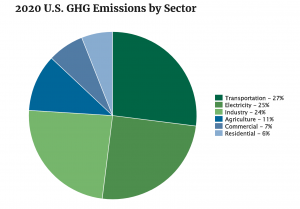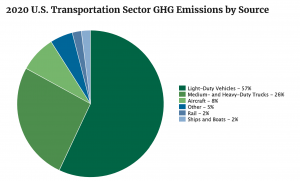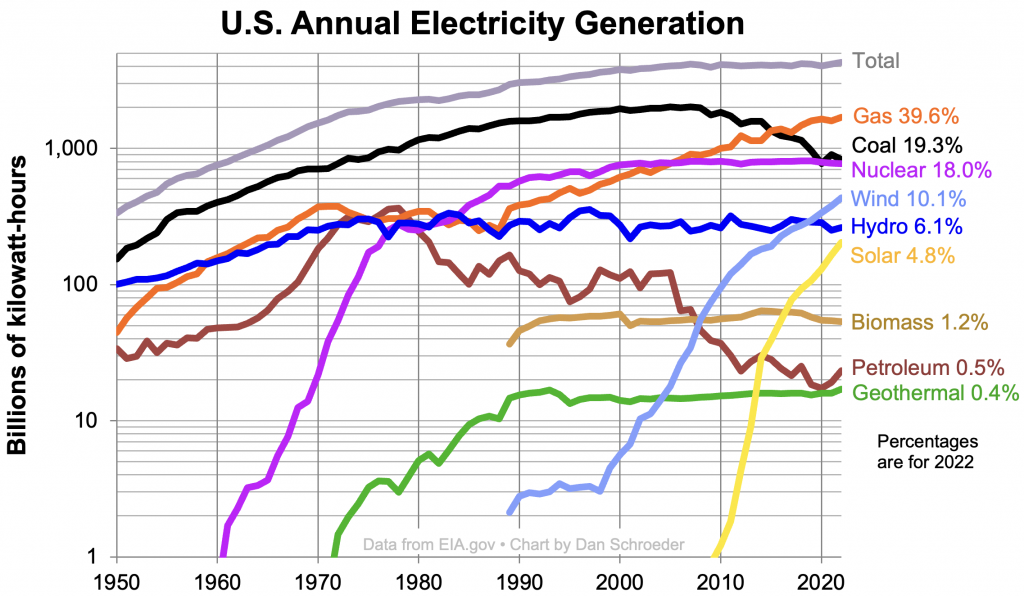Push For Electric Vehicles
Updated below:
The Administration is pushing for 2/3 of all new vehicles to be electric by 2032 starting in Model Year 2027 which is only a few model years away. This year is Model Year 2024. Vehicle manufacturers have designed and are building the 2024 models to start selling and delivering in September. They’ve already started showing them at the big auto shows in Detroit, Chicago, New York, Atlanta, and more.
The EPA and the Administration are moving far too fast with the push. It’s all fine and dandy to say that they want 66% of all vehicles to be electric by 2032 but they aren’t looking at any other variables. At least they don’t seem to be.
They say that they’re going to reduce carbon and pollution. The EPA states that transportation is the largest source of greenhouse gasses in the US and cars are the largest part of that. Transportation is 27% of the total by sector. Cars (light-duty vehicles) are 57% by source. Another sector of greenhouse gasses is Electricity. That one is 25%. Change that 57% of the Transportation sector and add it to the Electricity Sector. Because you have to generate the electricity to charge the batteries for the electric cars.


So, your Transportation Sector is now 12% and your Electricity Sector is 40%.
You’ve cut off the bottom of the blanket and resewn it to the top.
Electric vehicles in a city reduce exhaust pollution. It does make it more pleasant for the people in the city. But the electricity has to come from somewhere. Coal, natural gas, and petroleum provide the fuel to generate power in 60% of the plants in the United States. Nuclear provides another 18%. The remaining comes from the so-called “renewables” hydroelectric (6.1%), geothermal (0.4%), biomass (1.2%), solar (4.8%), and wind (10.1%). Some of these, such as hydro and geothermal, are geographically locked. You can’t have a hydro plant in the middle of the desert. Solar and wind are also geographically limited. Windmills require areas where the wind blows consistently. Solar requires areas where the sun shines on more days than it doesn’t. Wind and solar farms can’t go just anywhere.
In order to reduce the 60% of power plants fueled by coal, natural gas, and petroleum they’ll have to be replaced by nuclear plants which aren’t as geographically limited. Solar and wind aren’t going to reduce or replace the coal- and gas-powered plants. Even though there was a reduction in coal-powered plants, they were replaced by gas-powered plants, not “renewable”-powered plants.

Wind creates unrecyclable waste when the huge fiberglass blades are disposed of. The masts are steel and can be recycled. Solar panel recycling is under study in the US and isn’t commercially viable at this time so they go in landfills unless someone can reuse or refurbish and reuse them.
Then there’s the infrastructure. The administration touts the addition of many EV charging stations they are nowhere near as plentiful as gas stations. They may be counting on people charging their vehicles at home – but that requires that people install the proper home charging station which can require permitting in your location. It will also require a licensed electrician for installation. And, if you have more than one vehicle, you may require more than one charging station. This also adds to your monthly electric bill.
That’s if you’re a homeowner of a single-family home or maybe a semi-detached home. If you are in a multifamily family building or are a renter that’s a whole other ball of wax. Who pays the building’s electric bill? How will EV charging be billed? Are parking spaces assigned? Will they be? Will a condo association purchase pay-as-you-go charging stations or establish a contract with one of the established companies? The same questions can be asked of landlords and apartment buildings. There are some apartment complexes that are quite large with hundreds of units. How will they provide charging units?
How much will rents rise because of this?
Electric cars are more expensive than internal combustion engine cars. If an electric car loses power due to its battery dying it’s dead. It needs to be towed to a charging station and you have to wait until it’s charged to go anywhere else. If an ICE car runs out of gas someone can bring by a gas can with a gallon or five and you and your car can get to a nearby gas station and fill up in under 15 minutes and be on your way. Oh, and if the battery in your ICE car dies, it’s generally a matter of a jump start to get it going again and it will recharge while you’re driving. Replacement cost for the battery for an ICE car is generally under $150 and for an EV it can cost half the cost of the car itself.
Range is still longer with an ICE and refills are still shorter. Most of the EV charging stations are still Level 2 which is the slower charging. A Level 2 charger can charge an EV from empty to full in FOUR to TEN hours. Granted, you don’t want to be on empty on a road trip, but this necessitates more frequent stops for longer periods to keep your EV charged up. The DC Fast Chargers can charge to 80% in 20 minutes to an hour. Twenty minutes is a little more comparable to a visit to an interstate gas station with fill-up and snack and restroom break, but I’d guess that’s an outlier and the visits are more likely in the middle of the 20- to 60-minute range.
Update: Motortrend magazine has a real-world article about charging time for an EV vehicle…
Their Ford F-150 Lightning said it would take a little over an hour to go from the 13% (30 miles range) they were at to an 80% charge. This was at a 7-Eleven and one of their own branded 7Charge Fast Chargers. Their 80% brought them up to 227 miles of range and was 87.619kW of electricity at $0.59/kW for a total of $51.70. They also spent another $33.41 on drinks and snacks at the 7-Eleven while they were waiting for the truck to charge. That extra expense was, of course, completely unnecessary and not an actual part of the vehicle charge.
Our Chevy Silverado 1500 (similar-sized ICE) would have taken about 10 minutes including snacks and cost ~$60 for a 100% fill-up with a ~435-mile range.
Lithium mining to obtain the main component for the batteries for the EVs creates its own problems even if it can be startlingly beautiful.

So, as I said earlier, the EPA and Administration have decided to push for a mostly electric fleet of new cars starting in three model years to reach that goal by 2032 but they haven’t looked at the other variables. They decided and that’s that.
People’s Climate March
He talks about the Evil Koch Brothers™ quite a bit. It’s amazing how much those two men control!
Thanks Michelle!
Transcript below the fold.




